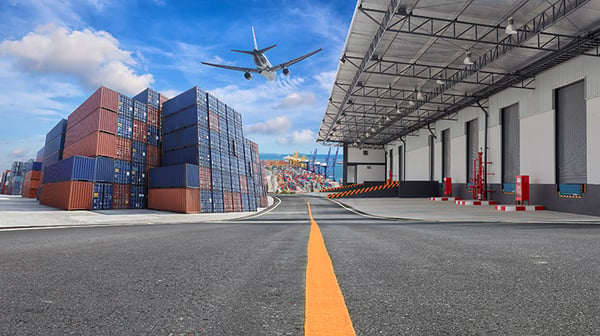If anyone questions why there's concern about transporting lithium batteries, refer them to the Federal Aviation Administration. Between March 20, 1991, and April 1, 2019, they logged 254 airline and airport incidents where a lithium battery either started smoking, caught fire, or exploded.
To be clear, not all lithium batteries are a problem, and this is a vanishingly small proportion of the number of batteries moved by air each year. But why take chances? In response, and to ensure continued safety in the air, aviation authorities have progressively tightened regulations on the transport of lithium batteries. Other modes of transport are also not exempt. A lithium battery fire on a ship, train, or truck could still have deadly consequences. This review of lithium battery transportation challenges explores:
- The Problem with Lithium Batteries
- Regulation and Restriction
- Lithium Battery Transport by Air
- Transport by Road and Rail
- Transport by Sea
- Battery Testing
- Packaging
- Education and Training
- Operational Impacts
The Problem with Lithium Batteries
Battery technology is driven by the need to increase energy storage density, which lithium helps achieve. Today there are two types of lithium battery: non-rechargeable dry cells, sometimes called lithium-metal, and rechargeable lithium-ion or Li-ion. Dry cell lithium batteries – the type used in flashlights and portable radios – don't pose the same challenges as Li-ion batteries. They are, however, still hazardous owing to the use of lithium, a metal that burns readily in air and at a temperature above the melting point of aluminum.
Inside a Li-ion battery, the anode and cathode are separated by a membrane just a few microns thick. In addition, there's an electrolyte that facilitates energy storage and transfer. To maximize in-service battery life, engineers have shrunk Li-ion cells to a point where energy densities of 160Wh/kg or more are now routinely achieved. Concurrently, this has increased the risk of short-circuiting or overheating.
The big problem with Li-ion batteries is the risk of thermal runaway. This is where a short-circuit, or just getting too hot, leads to the cell catching fire or even exploding. And when that happens, the reaction usually carries over to adjacent cells in a chain reaction. The result is a conflagration that can bring down an aircraft.

Regulation and Restriction
The potential hazards of Li-ion have led domestic and international safety agencies to implement a range of restrictions on battery transportation. The most onerous are those on movement by air, although rules also apply to sea, road, and rail transport. (Anyone who flies regularly will know airlines want rechargeable batteries kept with their owners/passengers and not in the hold).
Note that there are differences between the rules for batteries shipped contained in or packed with equipment and those shipped without equipment. There are also different limits for very small batteries. “Contained in” means the battery is shipped in the device it will power. For example, the battery in a cordless drill may be shipped either “contained in equipment” or “packed with equipment,” while batteries going to the U.S. for assembly into electrical devices are “without equipment.” The differences in shipping regulations relate principally to the number of batteries that may be placed in a package.
Lithium Battery Transport by Air
Tighter restrictions on dangerous goods went into effect April 1, 2016. These were first developed by the International Civil Aviation Organization (ICAO) as technical instructions before being turned into Dangerous Goods Regulations (DGR) by the International Air Transport Association (IATA.) These mandate:
- Lithium batteries without equipment must be transported exclusively in cargo-only aircraft.
- A 30% state-of-charge limit for batteries not installed with equipment. (This is to keep down the energy density).
- Limits on package quantity and overpacks.
- Requirements for shipping company certification and personnel education and training.
Be aware that the person/organization identified on the waybill as the shipper is 100% responsible for compliance with IATA DGR. In addition, batteries must be manufactured to conform to the international testing standard UN 38.3.
Transport by Road and Rail
Within the U.S., these fall under the remit of the Department of Transportation (DOT). Within the DOT, there exists a sub-agency, the Pipeline and Hazardous Materials Safety Administration, which regulates the movement of dangerous goods. Under 49 CFR 173.185, lithium batteries are designated as Class 9 Dangerous Goods (Class 9 referring to Miscellaneous Hazardous Materials).
49 CFR 173.185 is too long to explain thoroughly here, but there are some points to highlight. First, to quote directly from the Federal Regulation, “Each lithium cell or battery must be of the type proven to meet the criteria in part III, sub-section 38.3 of the UN Manual of Tests and Criteria.” In other words, compliance with UN 38.3 is required.
Second, there are extensive requirements for packaging and labeling. Anyone with responsibility for shipping Li-ion batteries would be well-advised to study the regulation carefully. And third, to ensure alignment in matters of international air transportation, 49 CFR references the ICAO Technical Instruction on which the IATA DGRs are based.
Transport by Sea
The applicable regulations here are set out in International Maritime Dangerous Goods Code 38-16. This adheres closely to the requirements set out by ICAO/IATA and in 49 CFR 173.185. Again, the key points are that batteries must be designed and tested to UN 38.3, use of suitable packaging, and appropriate training.
Battery Testing
United Nations standard 38.3 (the current version is Revision 6) defines eight tests that Li-ion batteries must pass to be considered safe for shipping. These tests are designed to replicate the extreme conditions batteries might encounter during transport and which are likely to cause internal damage leading to thermal runaway. The standard itself is quite lengthy, but the tests may be summarized as:
- T1 – Altitude
- T2 – Thermal
- T3 – Vibration
- T4 – Shock
- T5 - External short-circuit
- T6 – Impact
- T7 – Overcharge
- T8 – Forced discharge
Testing must be undertaken by a competent authority and at an approved test house. Note also that UL testing is not an alternative to UN 38.3.
Packaging
IATA regulations stipulate the use of “rigid” outer packaging that can withstand a 1.2m drop test. In addition, they require that batteries be enclosed in packaging made of non-conductive material such as polythene and that terminals be covered. Individual battery packages may be placed in an outer package (an overpack).
The definition of “rigid” is somewhat vague. UN-certified packaging materials are readily available and enough for customs authorities and shippers around the world.
Note also the stringent labeling requirements: all lithium battery packages must be clearly identified, in a manner and style meeting IATA rules. Overpacks must also be identified as such.
Education and Training
Any company involved in shipping lithium batteries by air must be certified to do so. Obtaining this certification requires that the people involved in shipping lithium batteries have received appropriate education and training in the rules applicable to hazardous materials. In addition to passing a test at the end of a formal class, annual re-certification is also required.
Operational Impacts
The increasingly tight regulations surrounding transport of lithium-metal and Li-ion batteries will affect manufacturers, shippers, assemblers, and distributors of electrical devices in several ways.
The state-of-charge requirement will compel manufacturers to discharge batteries after assembly and testing and prior to packaging. End users will also have to charge equipment before first use, and documentation should make this clear to avoid any customer complaints.
New battery designs must be tested to the latest revision of UN 38.3 regulations. Remember that these tests are destructive, so prototype quantities should be increased accordingly, and sufficient time incorporated into production schedules. Typical regulatory testing is around six weeks to complete but need to also factor in timing to assemble the required samples, which will vary from suppliers.
Shipping companies generally use separate locations for hazardous goods. This may limit the volumes/quantities handled per day/week/month.
Lead times will increase. Already, delays in shipments from Asia are becoming more common, and rejections have occurred. While prototype equipment can still be shipped, this too is becoming more complex. Assemblers/distributors/resellers should plan accordingly.
Looking ahead, prudence suggests all those involved with the lithium battery supply chain anticipate further tightening of regulations. This could conceivably include a partial or even complete prohibition on shipping Li-ion batteries by air.
Summary
With their high-energy density, Li-ion batteries have become an essential component of many cordless electrical devices (not to overlook plug-in hybrid and electric vehicles.) However, this same attribute also makes them hazardous to transport. In particular, there is a high risk that any internal damage, from shock, vibration, altitude, etc., could result in thermal runaway, leading to a large fire.
To address this risk, Li-ion, and lithium-metal batteries, are classed as Dangerous Goods and are subject to stringent regulations on packaging, documentation, and transport. While this blog post provides an overview of the issues, topics, and requirements, it should not be considered definitive advice. Always contact a specialist in lithium battery shipping before entering into transportation agreements. Lithium battery transportation is a complex area, and this is only an overview. For detailed guidance, please contact an expert in the field.
Key Takeaways
- Lithium batteries pose real transport risks: The FAA recorded over 250 incidents between 1991 and 2019 where lithium batteries smoked, caught fire, or exploded. The main danger lies in thermal runaway, especially in lithium-ion cells, where overheating or short circuits can cause chain reactions.
- Strict regulations govern all transport modes: Aviation rules are the most stringent, requiring cargo-only aircraft for loose batteries, a 30% state-of-charge limit, and certified shippers. Road, rail, and sea shipments also fall under DOT and international dangerous goods regulations, with all requiring compliance with UN 38.3 testing.
- UN 38.3 testing is mandatory: Batteries must pass eight destructive tests, including altitude, vibration, shock, thermal, short circuit, impact, overcharge, and forced discharge. Passing UL tests alone does not meet these shipping requirements.
- Packaging and labeling are tightly controlled: IATA rules mandate rigid packaging, insulation of terminals, and clear labeling. UN-certified packaging materials are widely available, but all shipments must meet drop-test standards, and overpacks must also be properly identified.
- Operational and business impacts are significant: Manufacturers must discharge batteries before shipment, plan for destructive testing timelines, and expect longer lead times and possible shipment rejections. Ongoing tightening of regulations means companies should anticipate future restrictions, potentially even bans on certain air shipments.
















